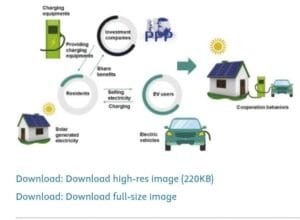How did the Sunmobile help define the technical feasibility of solar-powered mobility?
The Sunmobile Defined the Technical Feasibility of Solar-Powered Mobility:
Pioneering the Future The idea of solar-powered vehicles has long inspired innovation in the fields of sustainable transportation and renewable energy. Even though the solar cars of today are impressive engineering feats, the Sunmobile, a modest but revolutionary invention, was the inspiration for them. developed by William G. in 1955 The Sunmobile, designer by Cobbler, a GM Engineer, waste the first’ Vehicle in the World to use solar power. Even though it was only a 15-inch model, this small car made solar-powered transportation technically possible. The Sunmobile laid the groundwork for concepts that engineers, scientists, and innovators would build upon for decades to come by demonstrating that sunlight could be used to power motion.

Motors Powerama auto show in Chicago as a straightforward demonstration device. Twelve roof-mounted selenium photovoltaic cells powered Cobb’s small car, which was built primarily for educational and demonstration purposes. A small electric motor attached to the wheels was powered by these cells, which turned sunlight into electrical energy. The vehicle moved when it was illuminated, demonstrating that solar energy could be directly converted into mechanical motion without causing pollution or combustion.How did the Sunmobile help define the technical feasibility of solar-powered mobility?
conceptual clarity, even though it was not intended for practical transportation. It bridged the gap between observable mechanics and theoretical possibilities. The application of solar energy was largely restricted to isolated experiments and scientific theory prior to the Sunmobile.
The fact that Cobb’s invention provided a tangible representation of solar-powered motion sparked additional research into photovoltaic technology and alternative transportation energy sources. By demonstrating solar cells as a viable energy source for mobility, the Sunmobile played a significant role in defining feasibility. At the time, photovoltaic technology was still in its infancy. Only a year earlier, in 1954, Bell Labs had developed the first practical silicon solar cell.
The adaptability of solar power in small, portable systems was highlighted by Cobb’s decision to use selenium cells, a less efficient but more readily available option at the time. Even though the efficiency of the energy conversion was low, the fact that sunlight alone could propel a car, even a model one, demonstrated that the idea had legs. Furthermore, the Sunmobile indirectly emphasized the significance of energy efficiency and lightweight design in solar-powered transportation. Due to the limited electrical output of the time’s solar cells, the vehicle needed to be extremely light and friction-free to function.How did the Sunmobile help define the technical feasibility of solar-powered mobility?
This is still true today: successful solar cars, like those that compete in competitions like the World Solar Challenge, are made with materials that are extremely light and aerodynamic designs to get the most out of their power. Even though it was basic, Cobb’s model reflected this fundamental constraint and contributed to defining the technical parameters of future solar vehicles.
The Sun mobiles role in promoting solar power and igniting public interest was another significant contribution. Cobb contributed to the transformation of solar energy from an obscure scientific concept into something that the general public could see and comprehend by developing a concrete illustration of solar mobility. Thousands of visitors to Powerama, a major public exhibition, were introduced to the idea of harnessing solar energy for everyday use during the car’s demonstration.

This visibility contributed to the development of a cultural narrative regarding solar energy, which ultimately influenced technological investment and policy discussions. In addition, the Sunmobile indirectly encouraged photovoltaic technology innovation and research. Engineers sought to improve the efficiency, durability, and cost-effectiveness of solar cells as interest grew. Since then, these advancements have made it possible to create solar vehicles that can carry passengers and travel significant distances at high speeds.
Even though Cobb’s invention was never intended to be scaled up for human transportation, it started a technological journey that continues today. The Sunmobile must also be viewed within its historical context. The world was firmly rooted in the fossil-fuel paradigm in the 1950s. It appeared futuristic, if not fantastical, to use the sun as a practical energy source for mobility.
However, the Sun mobiles very existence shattered that framework and opened the door to discussions about alternative energy sources. It was, in essence, a preliminary prototype that provided a compelling argument for why future advancements in solar mobility were both necessary and attainable as well as a glimpse of what was possible. In conclusion, although the Sunmobile was a small model, it had a significant impact on the development of solar-powered mobility. It was the first clear and illustrative demonstration of how solar energy could be used to drive a car.How did the Sunmobile help define the technical feasibility of solar-powered mobility?
The Sunmobile contributed to defining the technical feasibility of a concept that would develop into a crucial component of sustainable transportation by validating the fundamental mechanics of solar-powered motion, highlighting the significance of efficient design, and generating public and scientific interest. The Sun mobiles legacy endures not as a relic of the past but as a blueprint for the future as solar technologies continue to advance and the world increasingly looks toward clean energy solutions.
